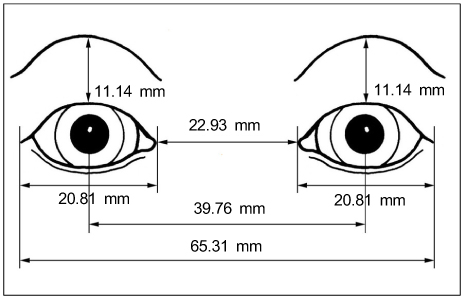J Korean Ophthalmol Soc.
2012 Oct;53(10):1385-1391.
Anthropometric Measurements of Soft-Tissue Orbits in Korean Newborns
- Affiliations
-
- 1Department of Ophthalmology, Soonchunhyang University College of Medicine, Seoul, Korea. scheye@schmc.ac.kr
Abstract
- PURPOSE
To establish a database of the anthropometric measurements of soft-tissue orbits in Korean newborns.
METHODS
A total of 69 normal term newborns (39 males, 30 females) in the first 48 hours after delivery, were included in the present study. Anthropometric measurements of soft-tissue orbits were taken with vernier calipers by one of the authors. With eyes closed, horizontal eyelid fissure length (HFL), lower lid height (LLH), upper lid height (ULH), intercanthal distance (ICD), and inter-outercanthal distance (IOCD) were measured and with eyes opened with a speculum, the interpupillary distance (IPD) was measured.
RESULTS
There was no significant difference between either sex or between the right and left eyes. HFL was 20.8 +/- 1.2 mm, LLH and ULH were 11.1 +/- 2.3 and 16.5 +/- 2.5 mm, respectively; ICD, IPD, and IOCD were 22.9 +/- 2.1 mm, 39.8 +/- 3.0 mm, and 65.3 +/- 5.8 mm, respectively.
CONCLUSIONS
Anthropometric measurements of normal Korean newborns' soft-tissue orbits in the present study can be used as basic data for the proper evaluation and growth of soft-tissue orbits.
Figure
Reference
-
1. Kim JY, Na KS, Choi GJ. Analysis of eyelid crease position in children. J Korean Ophthalmol Soc. 1996. 37:14–18.2. Kim HS, Lew H, Yun YS. The morphological and functional characteristics of eyelid in Korean children. J Korean Ophthalmol Soc. 2002. 43:1699–1705.3. Ozkağnici A, Büyükmumcu M, Zengin N, et al. Ocular and periorbital anthropometric measurements in term Turkish newborns. Surg Radiol Anat. 2001. 23:321–324.4. Wu KH, Tsai FJ, Li TC, et al. Normal values of inner canthal distance, interpupillary distance and palpebral fissure length in normal Chinese children in Taiwan. Acta Paediatr Taiwan. 2000. 41:22–27.5. Madjarova LM, Madzharov MM, Farkas LG, Katic MJ. Anthropometry of soft-tissue orbits in Bulgarian newborns: norms for intercanthal and biocular widths and length of palpebral fissures in 100 boys and 100 girls. Cleft Palate Craniofac J. 1999. 36:123–126.6. Blake CR, Lai WW, Edward DP. Racial and ethnic differences in ocular anatomy. Int Ophthalmol Clin. 2003. 43:9–25.7. Leung AK, Ma KC, Siu TO, Robson WL. Palpebral fissure length. In Chinese newborn infants. Comparison with other ethnic groups. Clin Pediatr (Phila). 1990. 29:172–174.8. Shapiro MB, France TD. The ocular features of Down's syndrome. Am J Ophthalmol. 1985. 99:659–663.9. Walia BN, Bhalla AK. Palpebral fissure length in normal infants. Indian Pediatr. 1989. 26:57–60.10. Fok TF, Hon KL, So HK, et al. Craniofacial anthropometry of Hong Kong Chinese babies: the eye. Orthod Craniofac Res. 2003. 6:48–53.11. Evereklioqlu C, Doqanay S, Er H, et al. Interpupillary index: a new parameter for hypo-hypertelorism. J Craniomaxillofac Surg. 2001. 29:191–194.12. Quant JR, Woo GC. Normal values of eye position in the Chinese population of Hong Kong. Optom Vis Sci. 1992. 69:152–158.13. Cohen MM Jr, Richieri-Costa A, Guion-Almeida ML, Saavedra D. Hypertelorism: interorbital growth, measurements, and pathogenetic considerations. Int J Oral Maxillofac Surg. 1995. 24:387–395.14. Korea Association for Pediatric Ophthalmology and Strabismus. Esodeviation II. Current concepts in strabismus. 2008. 2nd ed. Naewae Haksool;194. chap. 11.15. Fuchs M, Iosub S, Bingol N, Gromisch DS. Palpebral fissure size revisited. J Pediatr. 1980. 96:77–78.16. Jones KL, Hanson JW, Smith DW. Palpebral fissure size in newborn infants. J Pediatr. 1978. 92:787.17. Laestadius ND, Aase JM, Smith DW. Normal inner canthal and outer orbital dimensions. J Pediatr. 1969. 74:465–468.18. Thomas IT, Gaitantzis YA, Frias JL. Palpebral fissure length from 29 weeks gestation to 14 years. J Pediatr. 1987. 111:267–268.19. Farkas LG, Bryson W, Klotz J. Is photogrammetry of the face reliable? Plast Reconstr Surg. 1980. 66:346–355.
- Full Text Links
- Actions
-
Cited
- CITED
-
- Close
- Share
- Similar articles
-
- Changes in soft tissue chin resulting from premolar extraction and incisor retraction in adult female patients.
- Comparison of asymmetric degree between maxillofacial hard and soft tissue in facial asymmetric subjects using three-dimensional computed tomography
- A longitudintal study of soft-tissue profile changes in Korean adults aged from 24 to 32 years
- The Change of Bone and Soft Tissue Profile after Sagittal Split Osteotomy of Ramus
- Diagnostic Value of the Measurement of the Pre-vertebral Soft Tissue in Patients with Cervical Spine Injury



